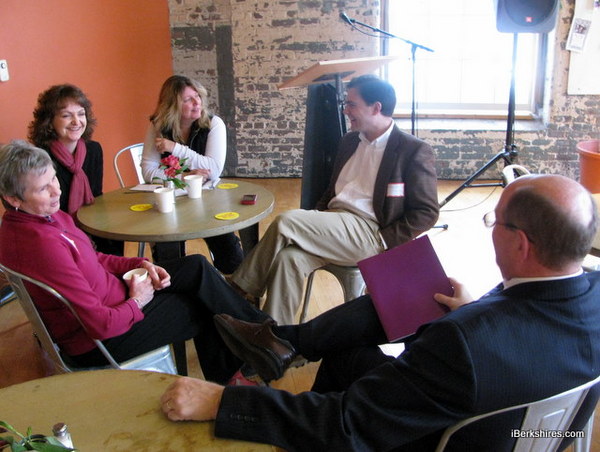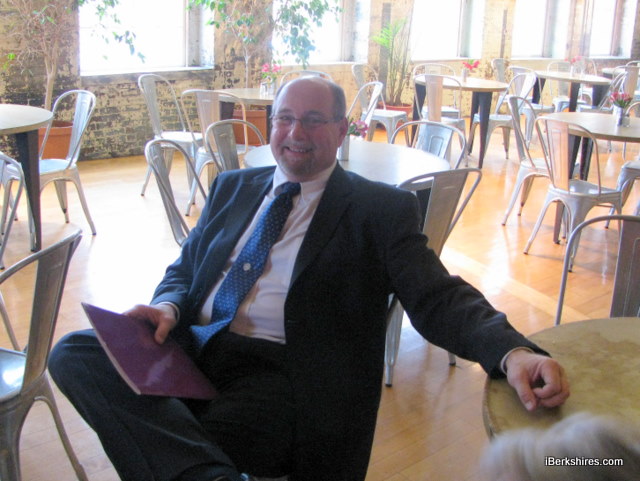
Alcombright Calls for Regional Collaboration
 Mayor Richard Alcombright spoke at the Williamstown Chamber breakfast at Mass MoCA. |
"I'm convinced that none of our communities — none of our communities — can truly grow without acknowledging the assets and the liabilities of the communities of North Berkshire as a whole," he told members and guests of the Williamstown Chamber of Commerce on Wednesday morning. "We need to re-engage at all levels. The first step will be to build strong relationships with our North Berkshire neighbors and welcome collaborative development efforts."
He listed the Hoosic River Revival, the Berkshire Bike Path and regional transportation efforts as among issues that would benefit from cross-border collaboration.
Alcombright said he was meeting with the town managers and administrators of Williamstown, Florida, Clarksburg and Adams on Thursday to brainstorm ways to "better utilize each other." It's the first of what he hopes will be regular sessions.
"We're much more visible as Northern Berkshire," he said, than as separate entities.
More than 50 people braved the wintry weather to attend the chamber's monthly breakfast that was held at Lickety Split at the Massachusetts Museum of Contemporary Art. Among them were Williamstown Town Manager Peter Fohlin, Adams Town Administrator Jonathan Butler and Councilor Lisa Blackmer.
The city's new mayor touched on some of the challenges ahead - understaffed departments, aged infrastructure, blighted housing and poverty. Property taxes have been kept low by attrition, he said. "The problem now is that we're out of options; as a community, we need to agree on what levels of public service are adequate and then deal with and accept the costs."
"There are two ways out - economic growth or raising fees and taxes," he said. He's charged the City Council with finding new efficiencies and revenue streams and ways to market the area for cultural and commercial growth.
But North Adams can't do it alone, said Alcombright. Building a sense of cooperation within the city, through the engagement of councilors, boards, civic groups and the use of NorthAdamsIdeas.com, is important but it also has to happen on the regional level, as well, he said.
He's already met with U.S. Rep. John W. Olver and various regional panels, and plans to meet with U.S. Sen. John Kerry soon.
"I've also had several conversations with the governor to let him know very specifically what our hopes are for North Adams and North Berkshire," Alcombright told the audience.
The new administration is hoping to thaw the often frosty relations the city has had with its neighbors over the years. The city's tussled with Williamstown over its shared waste-water plant and the runway extension at the Harriman & West Airport, and with Adams over developments on the city's southern border.
The communities should be working together as much as possible, said Alcombright, adding that jobs created in one town will inevitably help the others.
"We have a common destiny, we have common concerns ... transportation, education, public safety and, above all, the creation of jobs and more jobs," he said. "Those are the common threads that bind us together as North County."















